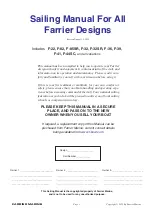
If there is any concern about the condition of any component of
the braking system, have an authorized Malibu trailer dealer review
and rectify the matter before towing the boat.
• Prior to
EACH
towing:
Check the fluid level in the reservoir on the trailer frame. The fluid
level must be maintained with 3/8” to ½” below the filler opening.
If brake fluid is needed, add only
new, clean DOT3 Premium Brake
Fluid.
Use caution when removing the filler cap to prevent the
introduction of dirt and/or contaminants into the fluid reservoir.
Do not use brake fluid drained from
the brake system to refill the master
cylinder reservoir as such fluids contain
contaminants from the system that may result in brake failure or
costly repairs.
• Check to be certain the breakaway battery is charged and that the
breakaway works. This is accomplished by pulling the cable on
the breakaway switch. If the vehicle has been parked for extended
periods of time, the breakaway battery may be discharged. If
that occurs, charge the breakaway battery in accordance with
the manufacturer’s recommendations prior to operation. If the
battery is allowed to discharge in a cold environment there is a
possibility of freezing, which could cause damage to the battery.
Such damage may not be covered by warranty.
• Again, use caution when handling brake fluid as spilled fluid will
damage paint.
Appropriate installation, maintenance,
and repair procedures are essential for the
safe, reliable operation of vehicle brakes.
Anyone who undertakes to maintain or repair vehicle braking systems
must establish that they neither compromise their personal safety nor
the vehicle integrity by their choice of methods, tools, or parts.
124—Trailers
When Towed by 2006 Mid-Year or Later Ford, Chevy, GMC Truck
Equipped with a Factory Brake Controller
Any Malibu trailer with the electric over hydraulic brake system
installed and towed by a 2006 mid-year or later Ford or Chevy
truck may experience towing issues if the truck is equipped with an
optional factory-integrated trailer brake controller.
These trailer brake controller systems are intended to assist
with the trailer braking process. Because of the way these systems
are designed, however, they can prevent the electric trailer braking
system from engaging as intended.
This is NOT a malfunction of the
Malibu trailer.
New in model year 2021 was an electric over hydraulic brake
system equipped with an adapter for 2006 mid-year or newer Ford
and Chevy factory-integrated trailer brake controllers. If you have
a newer model year vehicle, test the brakes before leaving the
dealership. If the brakes are not working correctly, it takes only a
matter of minutes to plug in the adapter.
The trailer brakes should always be
maintained in top condition. This
includes checking the fluid level in the
actuator regularly. The actuator access location is via a cap on top
of the trailer tongue. The loss of brake function can result in loss
of control or the inability to stop the trailer, which could lead to
serious injury or death.
The breakaway cable should
never
be used as a substitute for
braking or as a parking brake.
Periodic inspection should be made of the electrical connector,
wiring, brake lines, and hose for the entire brake system to ensure
there are no abraded or bare wires, damaged steel lines, or cracked
and damaged hoses. During inspection verify that there are no loose
or hanging lines or wire that might drag or catch on objects/debris
while being towed.
Additional Options
Back-up Camera
To assist with safe backing, Malibu offers an optional back-up camera on
all Malibu trailers. Using an app on your mobile device, images are delivered
directly to assist during low-speed maneuvers, stationary position, or for
surveillance. For more information about the back-up camera, consult the
manufacturer’s user guide enclosed in your owner’s packet.
Depth Alarm
To assist with backing into the water to a depth sufficient to allow
safe unloading of the boat, Malibu offers an optional depth alarm on
all its trailers. When the correct depth has been achieved, a sensor
sends an alert to an alarm on the bow stand. The alarm will sound
until the tow vehicle is placed in Park (or a forward gear on manual
transmission-equipped tow vehicles).
Tire Pressure Monitoring System (TPMS)
Trailers equipped with the Tire Pressure Monitoring System
(TPMS) will have a component-specific manual as part of the trailer
owner’s packet. Owners and operators should review the entire
manual prior to operation. Important safety information is included
in the information provided.
• Complete the TPMS App set-up before driving.
• The driver or owner does not need to constantly view the
TPMS App. Warning notifications will be issued when abnormal
conditions are found in the tires. TPMS sensors transmit only
when installed on a vehicle moving at more than twenty (20)
miles per hour.
• The smart device with app installed needs to have Bluetooth
turned on and the TPMS App needs to be running in the background
in order to receive on-screen and audible warning notifications
when the device volume is turned on.
• The smart device should be in a viewing area that does not affect
normal driving.
• Check for any air leakage from the tires after the TPMS sensors
have been installed.
• The TPMS does not have a warning notification for sidewall
failure.
• However, the warning notifications for irregular tire pressure and
temperature may help prevent a failure.
• Regular maintenance and visual inspections of the tires is still
necessary.
Failure to follow the directions and
instructions in the TPMS manual can
result in component or tire failure, which
can lead to serious injury or death, and damage to the trailer that is
not covered under warranty.
















































